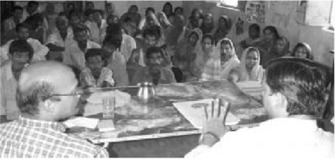Narayani, Chanda and Ghashi are battling for their lives. One of them is about to die. All of them are in a serious condition, suffering from silicosis. In time, they will have complete respiratory failure. These villagers of Lalkuan, near the Badarpur-Mehrauli Road in Delhi, require urgent medical attention. Peoples Rights and Social Research (PRASAR) has taken up this issue.
Silicosis is one of the oldest known occupational diseases caused by the inhalation of particles of silica, mostly from quartz in rocks, sand and similar substances. It is a progressive disease that belongs to a group of lung disorders called pneumoconiosis. It is identified by the formation of lumps (nodules) and fibrous scar tissues in the lungs. Narayani, Chanda and Ghashi got affected by this deadly disease due to exposure while stone-cutting. There have been others who have already succumbed to this disease. Since these workers were contract workers, they were not covered under the Employees State Insurance (ESI) scheme and have been denied compensation under the Workmens Compensation Act, 1923.
 Combined meeting organised by Central Board for Workers Education to educate
people on occupational health issues.
Combined meeting organised by Central Board for Workers Education to educate
people on occupational health issues.
Free crystalline silica, is one of the most common minerals in the earths crust. It is found in sand, many rocks such as granite, sandstone, flint and slate, and in some coal and metallic ores. The three most common forms are quartz, tridymite and cristobalite. Inhaled crystalline silica (in the form of quartz or crystobalite) is classified by the International Agency for Research on Cancer (IARC) as a Group 1 human lung carcinogen. One of the hazardous occupations that exposes laborers to such danger is stone-cutting.
The National Human Rights Commission (NHRC) took cognisance of a complaint lodged by PRASAR in mid-2003. The NHRC had directed that a copy of the complaint be sent to the Secretaries of the Union Health, Labour and Industry Ministries, the Labour Commissioner, the Government of the National Capital Region of Delhi and the Director, Pollution Control Department, Delhi. These agencies were asked to look into the allegations contained, and to submit their comments and an Action Taken Report within four weeks of receipt of NHRCs letter of August 19, 2003.
None of the departments mentioned have responded. The NHRC has sent a reminder to the departments concerned and these departments were to respond by 12th February 2004.
Stone-cutting had gone on in Lalkuan for more than 35 years till the Supreme Court of India ordered for the removal or dislocation of the crushers in early 1990s. Hundreds of stone-crushers were causing serious cough and respiratory diseases including tuberculosis among several thousands of people in the Tughlakabad area of New Delhi, says Professor T. Shivaji Rao, Director, Centre for Environmental Studies, Gitam Engineering College, Visakhapatnam. Contractors sell the stones to the government, builders and common house holders.
Hundreds of stone-cutters in Lalkuan, who were involved in stone-cutting to cater to the needs of infrastructure development of the city in the early 1990s, suffer from silicosis. Participatory Research in Asia (PRIA) and PRASAR had done a study in 2001 to gauge the extent of affected workers, based on interviews of 155 respondents and 58 oral autopsies. According to a paper by S.K. Sharma, J.N. Pande and K. Verma, Assistant Professors in the Department of Medicine at the All India Institute of Medical Sciences, published in the Indian Journal of Chest Diseases and Allied Sciences, October-December 1988, broncho-alveolar lavage fluid (BALF) analysis found the presence of silicosis in six patients.
Silicosis happens in several others industries besides stone-crushing. It is prevalent all over India. Similar cases have been reported in Pondicherry and Gujarat. In Orissa, stone crushing in Jajpur district has caused air, water and soil pollution. Diseases and deaths are rampant amongst the workers who are usually unorganized migrants from tribal districts like Keonjhar and Mayurbhanj. Nearly fifty villages which have been badly affected because of this activity of 500 crusher units. The WHO has confirmed the prevalence of silicosis among those engaged in the quarrying of shale sedimentary rock.
A meeting on Occupational and Environmental Health was held at the offices of Toxics Link in New Delhi, in August last year during which S.A.Azad of PRASAR made a presentation on the plight of the victims of the stone-crushing industry. He sought the support of the civil society groups present to launch a campaign to seek remedy for the silicosis victims. Toxics Link has been working on the environmental and occupational hazards resulting from toxics such as asbestos. Participants at the August meeting included Dr T.K. Joshi, Dr Sanjay Chaturvedi, A.T. Dudani, Ravi Agarwal, Nasir Atiq, Sunita Dubey, Ravinder Roy, Praveen Mote, Alpana, S.A. Azad and Gopal Krishna.
Stone-crushing can be carried in a safe manner by wetting the rocks before breaking and crushing and using modern machinery to minimize dust generation. Silicosis can be prevented by avoiding inhalation of dust containing free crystalline silica. Hence, preventing the formation and escape of dust is key. In the late 1930s, machine based dust control measures were introduced in developed countries like US in the late 1930s and by late 1960 the cases of Silicosis had almost vanished. In Switzerland, stricter controls in the 1970s and 1980s led to approximately six-fold reduction in the number of silicosis cases per year.
In India, contractors are not incorporating higher and less hazardous working standards into their process, despite the Supreme Court ruling. Profits have replaced worker safety and many workers have thus been failed by the system. Even records for occupational diseases are not maintained. The plight is best uunderstood from the fact that there are only 4 factory inspectors for whole of Delhi.
For the moment, the people of Lalkuan have lost all hope of receiving any compensation for being affected by such a deadly disease. Several civil society groups are stressing on the need for a public hearing on the issue.
